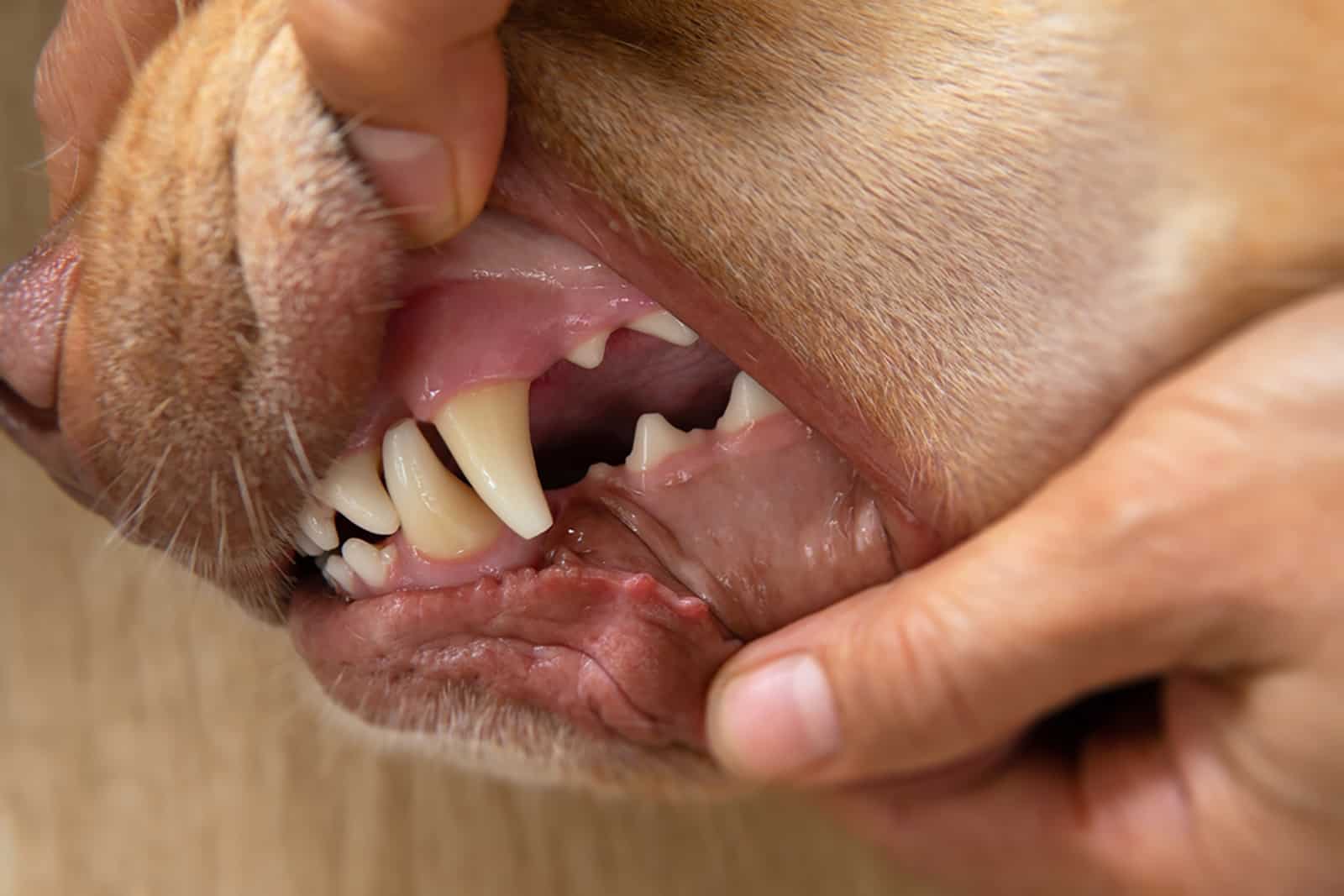Owning a dog is a truly wonderful experience until it is not. We all know that having a dog is a big responsibility and the biggest challenge is keeping it healthy and happy.
Dog health is the most important thing for every dog owner. This is why most of us panic when our dog shows changes in behavior or we notice something different in its appearance. So, we rush to the internet to find answers.
Today, you happen to notice that your dog’s gum color has changed. So that made you think:
What is considered unhealthy and what is a healthy dog’s gum color? How do I know if my dog’s gums are healthy?
Okay, let’s talk about healthy and unhealthy dog gums. We present you the dog gum color chart that features common color changes in your dog’s gums.
While the majority of dog gum color charts usually feature life-threatening conditions that make dog owners panic, even more, we figured it would be best to take a different approach to this common problem.
Now, I am not denying that dog gum color change can indeed be a life-threatening condition, but there is a lot more to talk about.
Dog Gum Color Chart Preview
As a responsible dog owner and veterinarian, my pet’s health is my top priority. I highly recommend that all owners occasionally check their dog’s gums.
To help keep track of healthy and unhealthy dog gum color, I decided to make a quick dog gum color chart.
So, here it is — a quick dog gum color chart preview to help start our journey:
[table id=553 /]
As you may have noticed, each dog gum color change requires a trip to the vet. That is how important it is whenever we notice that our dog’s gum color has changed.
It is something that should not be overlooked — dog gum color change requires an immediate veterinary check.
Why Dog Gum Color Is Important
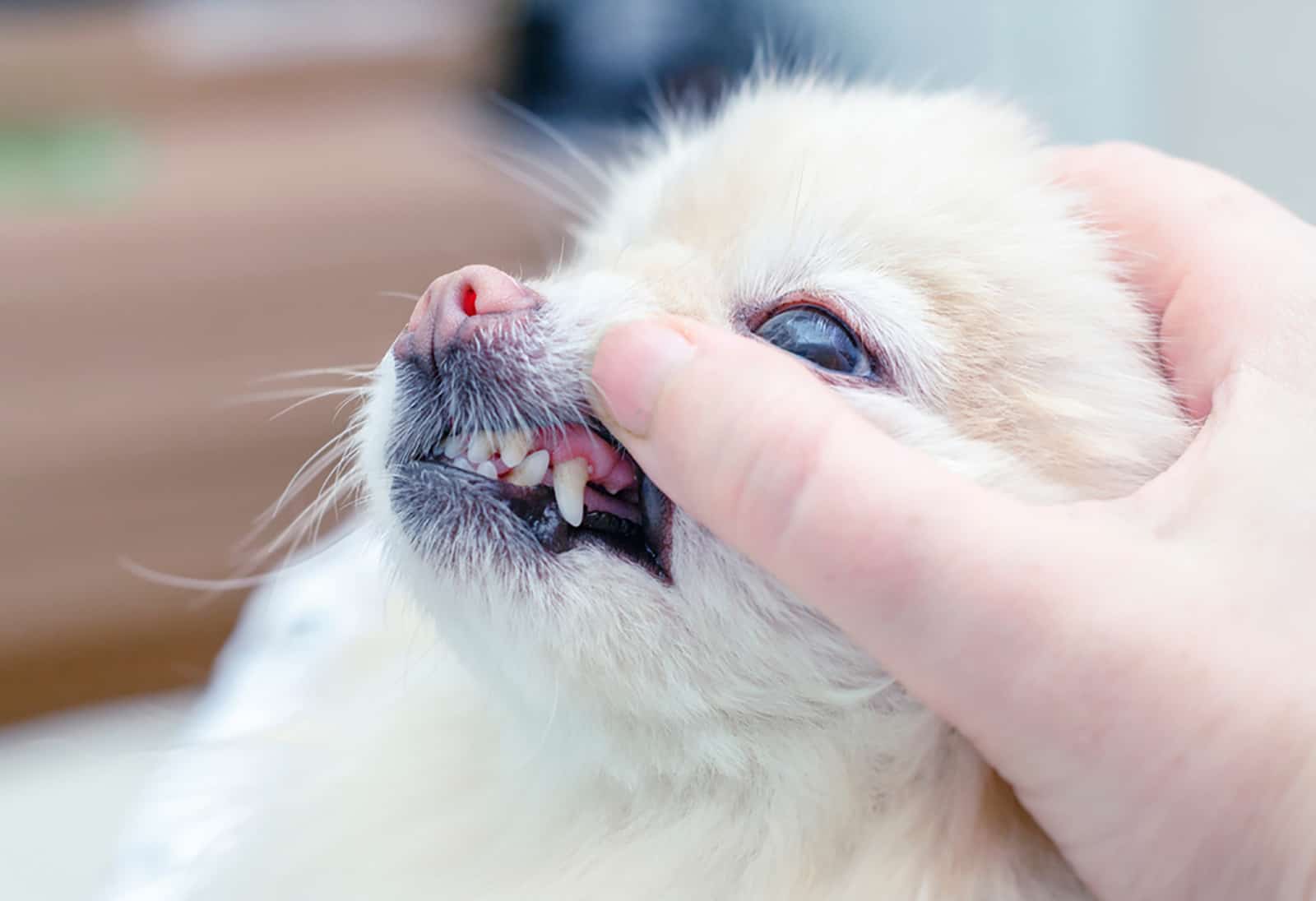
Dog gum color is often overlooked by dog owners. Now, let’s change that because dog gum color is a very important sign of its overall health condition!
Not only does dog gum color show different states of hydration, but it also shows whether or not a dog is suffering from a certain disease. Yes — as a worried owner you can tell if your dog is sick by looking at its gum color!
But in that case, a sick dog should be observed for more signs than just the gum color alone.
Before we begin, let me just say that your dog’s health can be tracked through the color of its gums!
What Color Are Gums In A Healthy Dog?
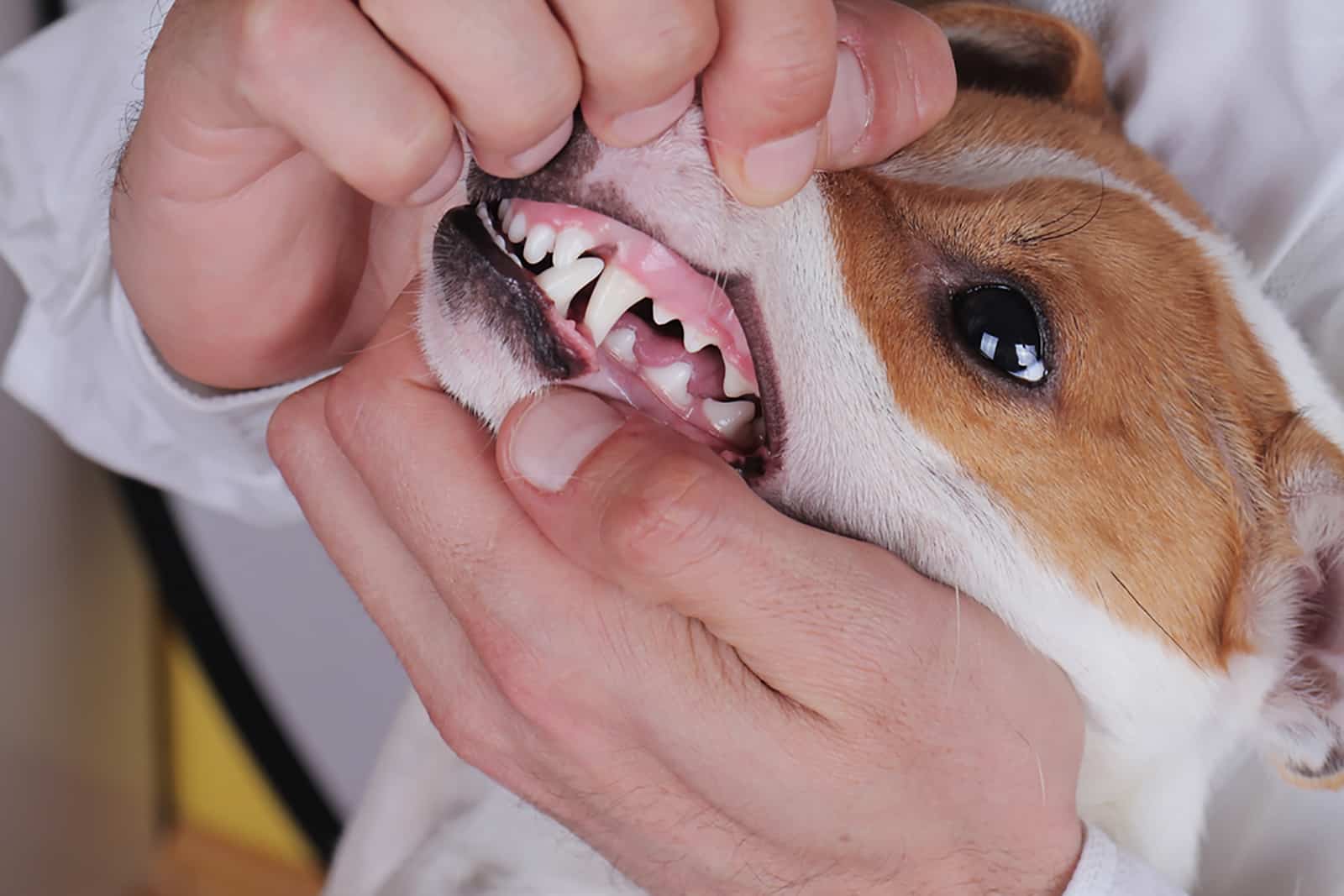
Pink color!
Before we learn more about unhealthy dog gum color, we should talk about healthy dog gum color first.
Dog gum health is indicated by its color which usually ranges from pale pink to bubble gum pink. Any other than that dog gum color is considered troublesome.
Depending on the hydration state, normal dog gums can vary in shades of pink but they should usually stay pale pink.
Don’t be confused because some dog breeds have pigmented gums. So, you can see shades of black, blue, brown, and purple on healthy dogs’ gums. This is simply a breed-specific thing. Like blue tongues in Chow Chows (their gums are also pigmented).
What Color Are A Sick Dog’s Gums?
Let’s talk about some serious stuff — sick dog’s gums. If you happen to notice any gum color except pale pink, you will likely have to schedule a vet appointment. Keep an eye out for the following colors of your dog’s gums:
• Red
• White
• Yellow
• Blue/purple
But, don’t panic, okay? It is good to notice if a sick dog’s gums change color because you can act as soon as possible and have your dog get checked.
What Do Unhealthy Gums Look Like In A Dog?
Let’s get right into the unhealthy dog gums that are telling you to take your dog to the vet as soon as possible.
We have prepared a whole specter of possible dog gum colors that indicate different health problems. Make sure to check them all out to find out if your dog is sick or not.
1. White Gums
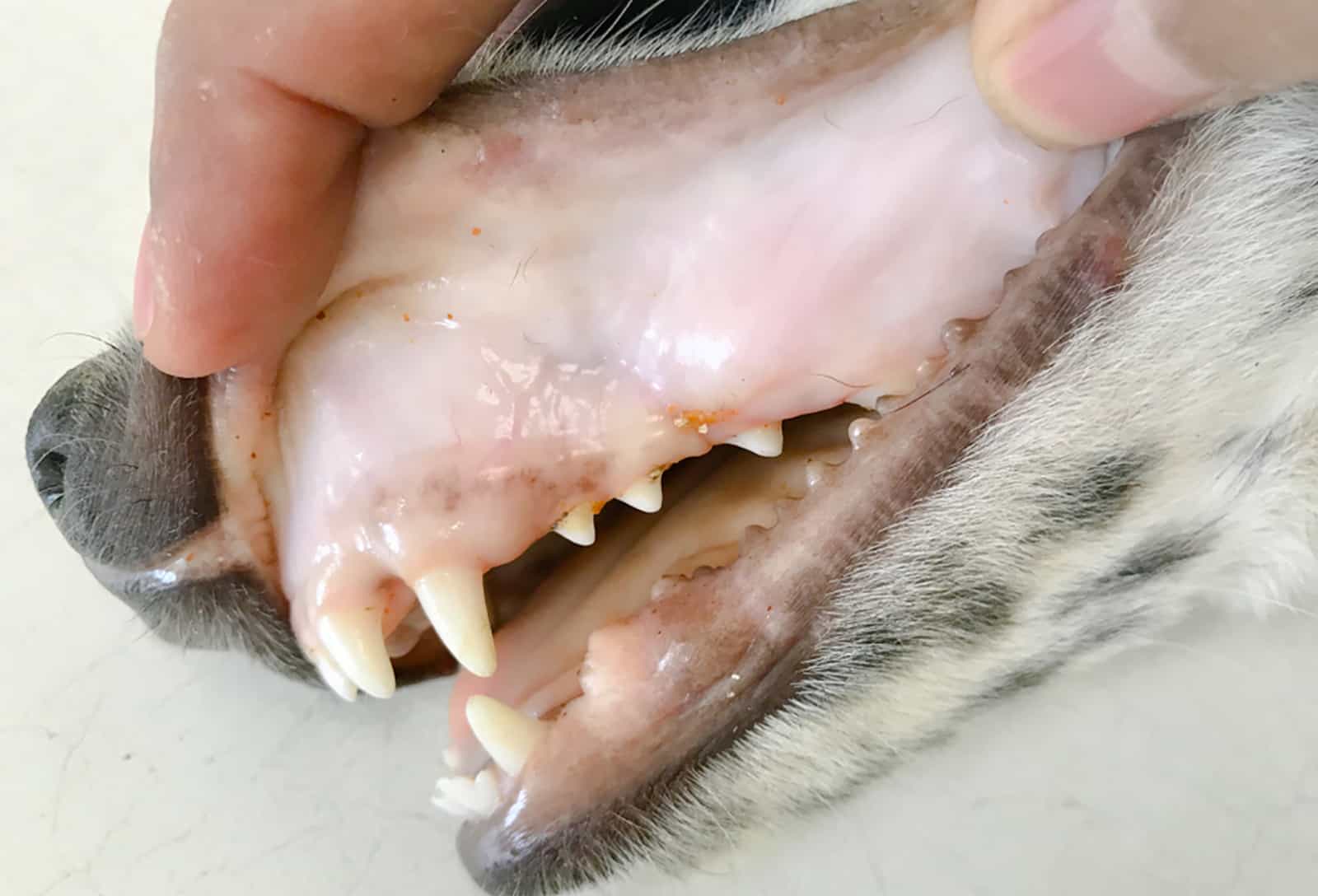
White gums in dogs can appear because of several reasons and not all are life-threatening. However, if you happen to notice white gums in your dog, do not wait to inform your veterinarian.
When compared to red dog gums, white gums may not seem so dangerous. But more often than not, white gums in dogs require a veterinary health check.
Here is what could be causing your pooch to have white gums:
Tooth Abscess
If the discoloration only affects a small portion of the dog’s gums rather than the entire surface, then we may be dealing with a tooth abscess.
When your dog’s tooth becomes infected, there is a high chance that an abscess (collection of pus) will develop. A structure called a draining fistula frequently develops along the gum line to release the infection’s strain on the dog tooth’s root.
This will appear as a white or yellow cyst near the dog’s gums or gum line.
Fungal Infection
Dog’s gums that are white and painful, especially white lesions, will feel sensitive and unpleasant.
If you detect white gums in your dog’s mouth, they are likely the consequence of a fungal infection and you should not wait for them to worsen.
Blood Loss
Usually, blood loss anemia in dogs is a result of surgery, various bleeding disorders, and internal or superficial bleeding (injuries).
Besides that, blood loss can occur as a result of a variety of factors, including trauma and severe parasite infestation from fleas and ticks.
Blood loss can be life-threatening and should always be treated as an emergency, so contact your veterinarian right away if your dog is bleeding.
Anemia
One illness that could make your dog’s gums appear lighter is anemia, for instance.
What happens during canine anemia? Well, red blood cells that carry oxygen throughout the body are decreased and your dog may experience trouble bleeding due to oxygen deprivation (extreme cases like canine Babesiosis).
The most blatant and typical clinical sign of anemia is pale pink or white gums. Other symptoms of anemia include weakness, lethargy, low appetite, and shortness of breath.
Shock
Shock in dogs is caused by low oxygen in the body that is linked to insufficient blood supply.
So, when there is a lack of proper blood supply and blood flow, cells and organs within the dog’s body do not receive enough oxygen and nutrients to function properly.
In other words, shock is a life-threatening condition caused by a sudden decrease in blood flow through the dog’s body.
Shock can be caused by a variety of factors, but it is most commonly associated with trauma, such as car accidents. Shock can be fatal if left untreated, so seek immediate veterinary attention.
Kidney Disease
Kidney disease in dogs can be linked to chemical intoxication, bacterial infections, ingestion of toxic foods and poisons, and so on. Many factors can cause kidney disease in dogs, but it can also be hereditary.
Bacteria from periodontal disease can enter a dog’s bloodstream, especially if the gums are inflamed and serve as an “access point.” This bacteria can harm not only the kidneys but also the heart and liver.
Progressive dental disease can be the leading cause of a dog’s kidney disease.
One of the many functions of the kidney is the production of a hormone that is called erythropoietin. This hormone has a very interesting function — it gives orders to the bone marrow to produce more red blood cells.
So you know what happens when a dog’s kidneys don’t work properly? Erythropoietin can’t be produced normally which means your dog’s body will lack normal red blood cell count.
That said, one of several possible symptoms of canine kidney disease is pale gums (caused by anemia).
2. Yellow Gums
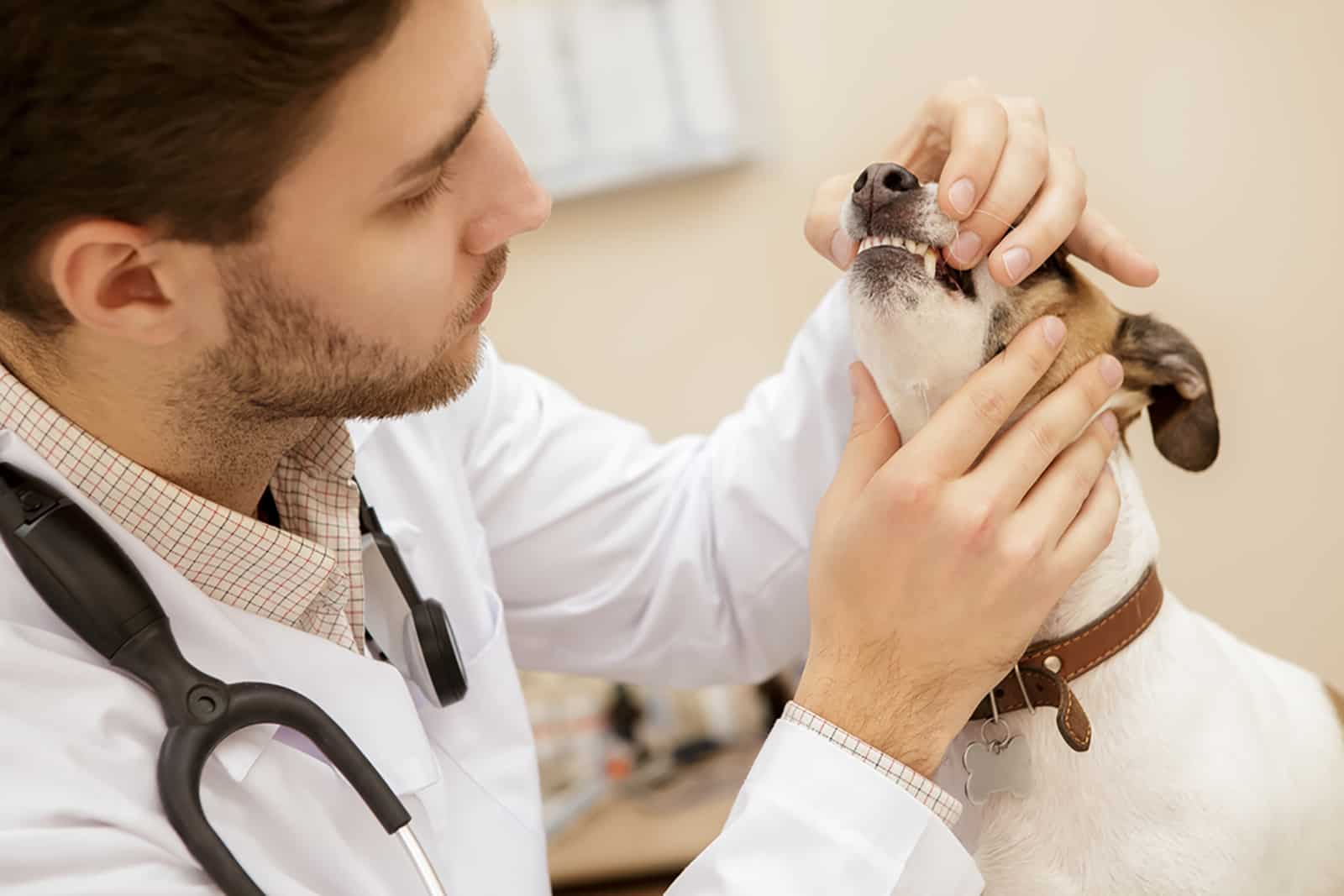
Yellow gums in dogs might signify several additional life-threatening conditions in addition to gingivitis.
Whenever someone mentions “yellow gums in dogs” the first thing that comes to mind is jaundice (icterus). But, it doesn’t have to be. It depends on what kind of yellow gums we are talking about.
If the yellow is very bright and even changes to orange, then it is most likely the case of canine jaundice.
However, if the yellow is pale, then it can be a sign of something less serious than jaundice, like gingivitis.
Canine Gingivitis
Canine gingivitis is indicated by a slight yellow tint or film on your dog’s gums. Gingivitis is commonly associated with inflamed and swollen gums too, so you can expect the yellow to turn into a cherry red.
This is a common condition that can be treated with a trip to the vet who will perform dental cleaning and help maintain your dog’s dental health.
A yellow sore, on the other hand, could be an indication of a viral infection, an ulcer, or periodontal disease.
Jaundice In Dogs
Jaundice in dogs is recognizable by a bright to deep yellow discoloration of the dog’s gums, as well as genital area and nostrils. High concentrations of bilirubin (which is a normal bile pigment) are to blame for jaundice.
This pigment derives from hemoglobin (found in red blood cells) that breaks down.
Jaundice in dogs can be a result of liver disease, liver obstruction, or a blood clotting condition. You must ascertain the source of your dog’s illness before attempting to treat the jaundice symptoms at home.
Right now, your best option is to take your dog with yellow gums to the veterinarian.
3. Red Gums
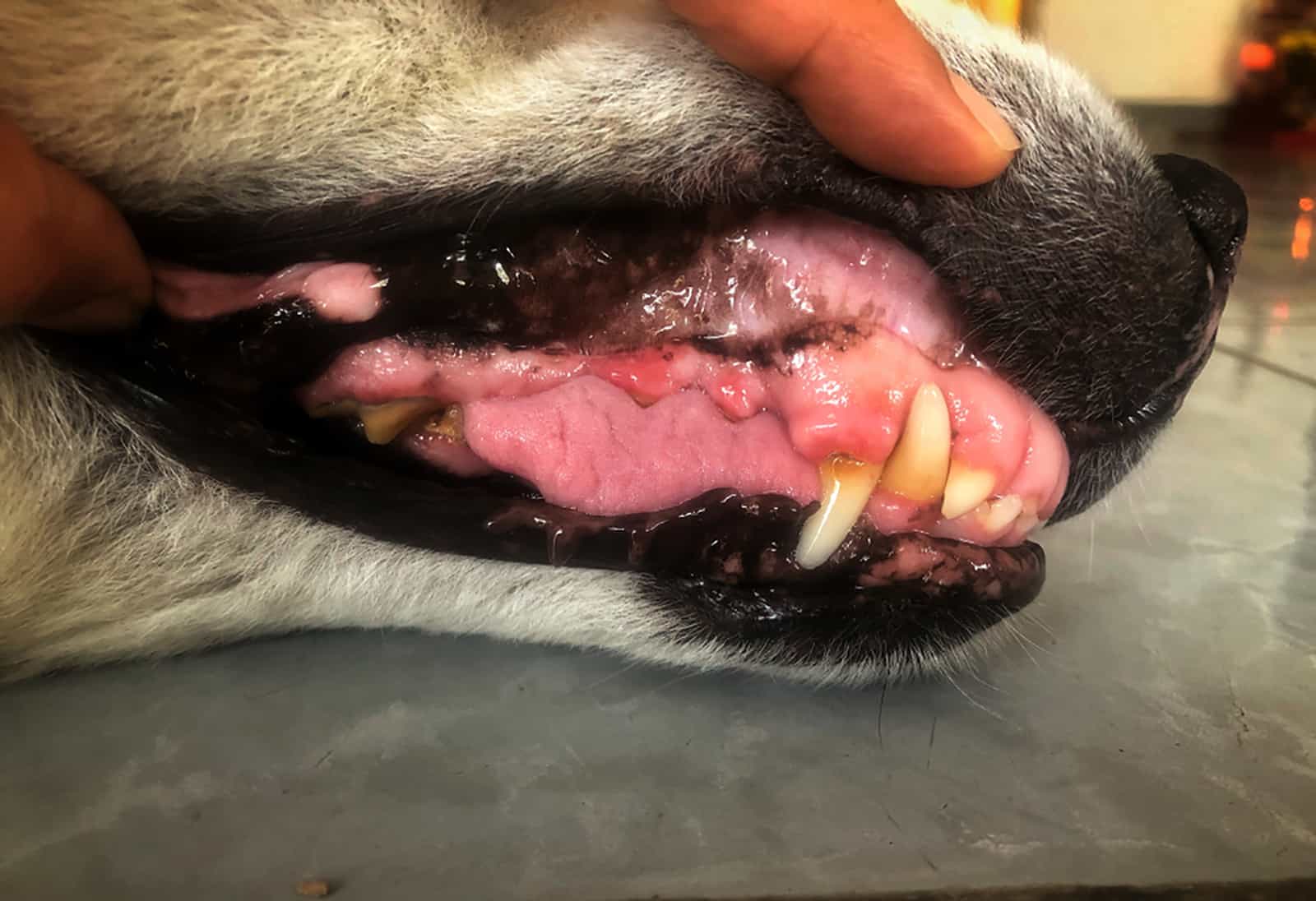
Red gums in dogs are a red flag! Bright red or cherry red gums are a no-no in the canine world. If you notice red gums, make sure to call your vet.
When the color of your dog’s gums is red, then you should assume it is suffering from the following health conditions:
Tartar Build Up
Tartar accumulation on the dog’s teeth is the root cause of gum disease.
Tartar builds up on your dog’s teeth and irritates its gums if you don’t frequently brush them and clean them in between them.
The tartar build-up makes your dog’s breath smell bad and once it progresses to a whole infection, then your dog might not want to eat at all. It becomes very painful as gums start to bleed.
Wet dog food is usually the culprit of creating tartar on your dog’s teeth.
This is because wet dog food only slides through your dog’s mouth, while dry dog food scrapes the accumulated tartar and, in a way, cleanses your dog’s teeth.
Gum Disease
Red gums in dogs are a sign of infection or inflammation. They’ll probably be sensitive, and they might even bleed when you touch them.
Gum disease is often called canine periodontal disease and it causes quite a mess in your dog’s mouth.
Carbon Monoxide Poisoning
If your dog breathes in carbon monoxide, a deadly gas, chances are it will find itself in a life-threatening condition. Carbon monoxide poisoning in dogs is a very serious and acute health problem that needs immediate veterinary intervention.
Carbon monoxide is a deadly gas with high toxicity that can kill your dog.
If they are improperly placed, broken, or poorly maintained, common home heating and cooking appliances may emit carbon monoxide.
Carbon monoxide poisoning in dogs is followed by high blood pressure, heat stroke, trouble breathing, and lethargy.
4. Blue Gums
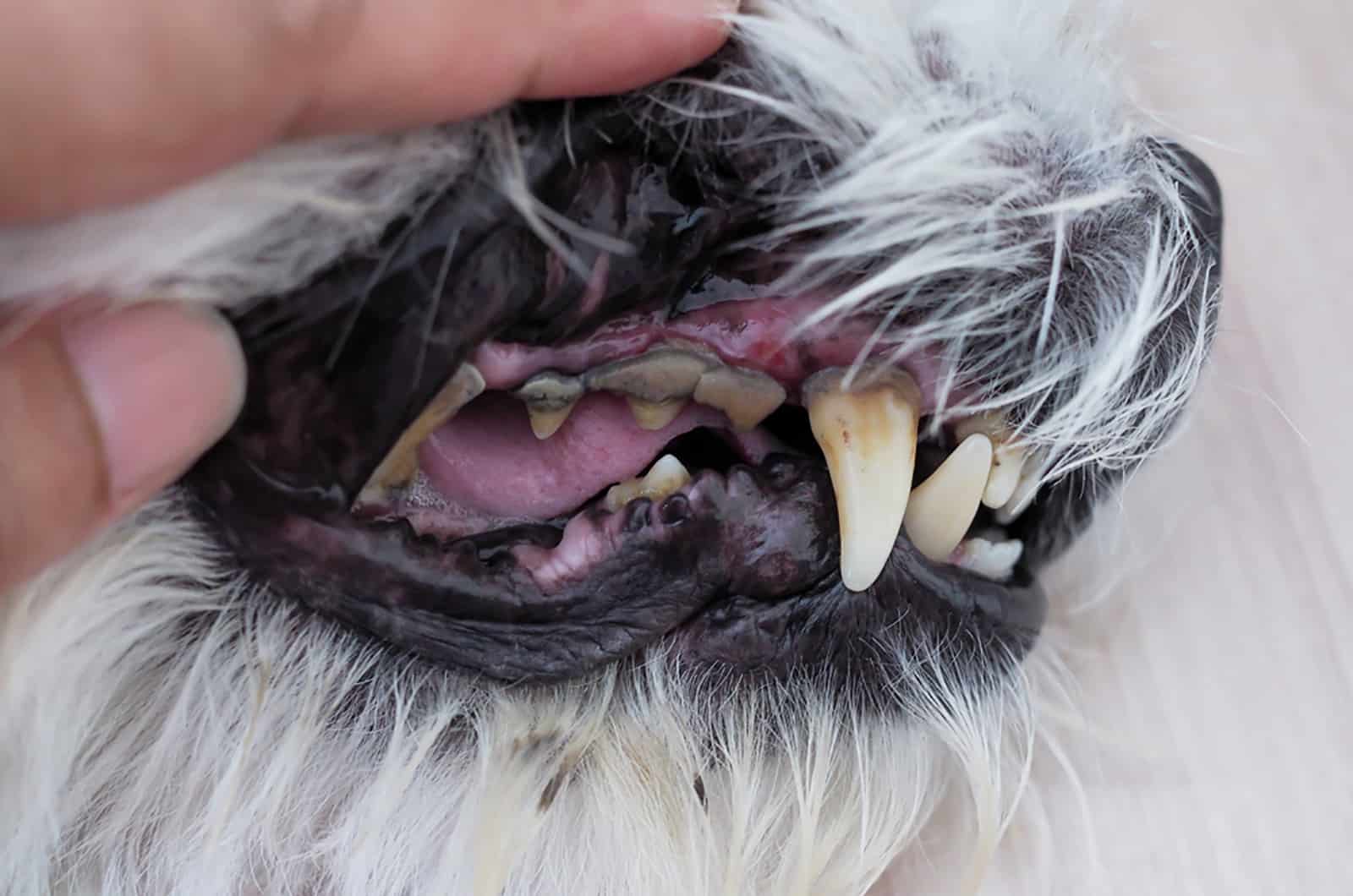
Do not ignore blue gums in dogs! They are almost always an emergency. Why did I say “almost”? Well, because some dogs have dark pigmentation in their gums that is natural to them.
However, this natural pigmentation occurs on different parts of the dog’s gums.
In this case, blue gums are completely colored pale blue to purple, which is not good.
Cyanosis
Blue gums in dogs may indicate internal bleeding, however, cyanosis is most likely the cause. Gums that appear blue because of a lack of oxygen are called cyanosis.
This is a clear indication of gum disease and other potential health issues. A medical disorder called canine cyanosis can make a dog’s skin and mucous membranes turn blue.
When red blood cells are unable to transport enough oxygen throughout the body, it occurs. Canine bloat, respiratory or heart disease that is underlying may frequently cause the disorder.
Circulatory problems might result in blue patches on the gums. The color of the gums can also be altered by several medicines.
A similar thing will occur if a person consumes metal salt poisoning.
5. Black Gums
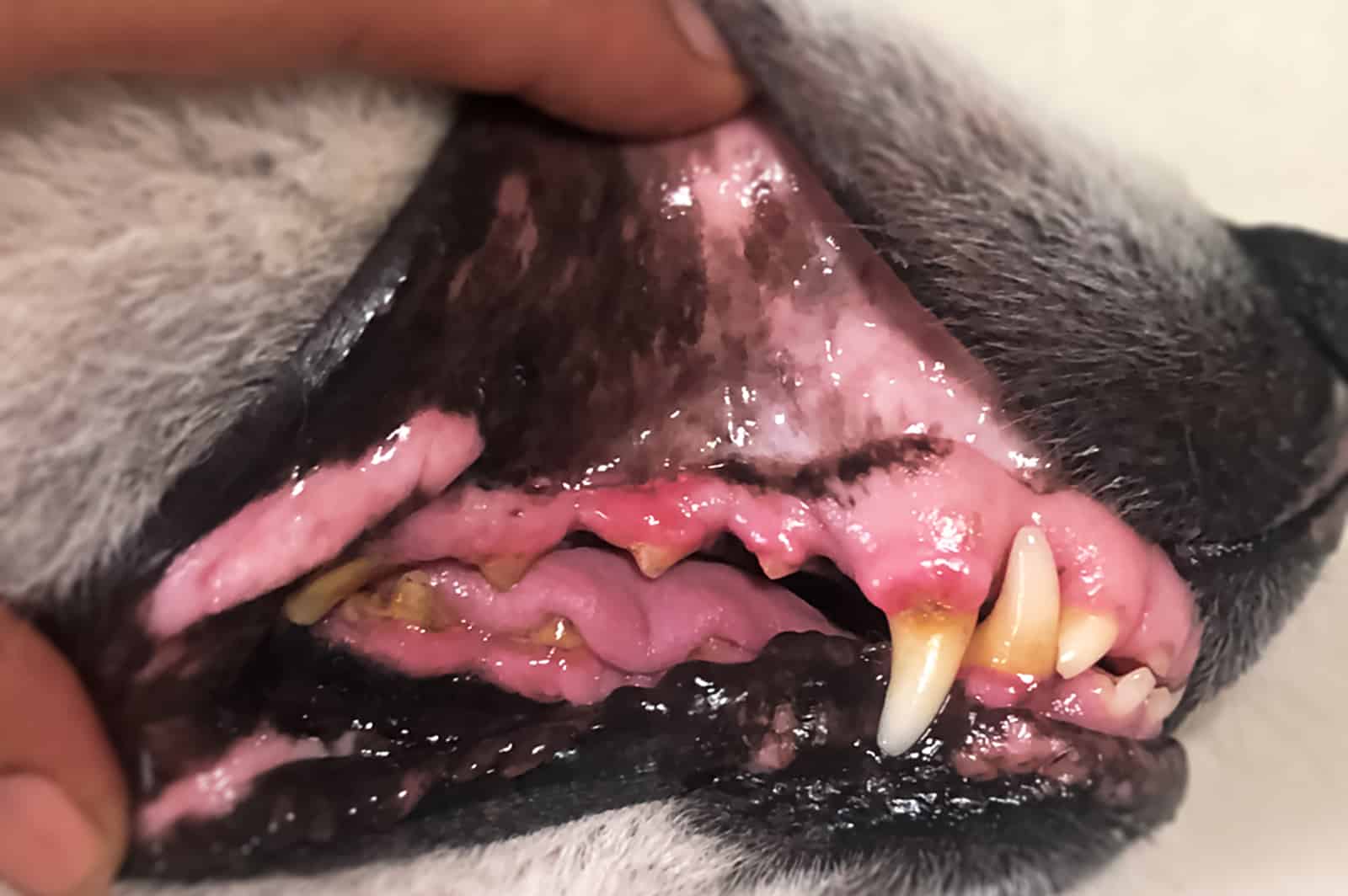
Black gums, like different skin tones, are natural and healthy and are the result of hereditary variances in pigmentation. Even a dog’s tongue color can be black or spotted!
There are numerous other symptoms you can check for to determine whether your pet is ill, even though dark-colored gums can obscure one sign of heart or lung issues.
Black gums can be an issue if your dog naturally doesn’t have black-colored gums. They may indicate the presence of tumors and growths on the gum tissue or inside the bone.
What Color Do Dogs Gums Turn When Dehydrated?
When a dog is dehydrated, its gums are pink, but a very pale pink color. Dehydrated dog’s gums feel sticky to the touch and they don’t look as shiny as they used to.
Dehydration is characterized by deep red, sticky gums, which in the heat can also be a precursor to heat stroke.
You should look out for other signs that show your dog is dehydrated. Besides gum color change, your dehydrated dog will show signs of lethargy, loss of skin elasticity, brittle and dry coat, dry nose, and sunken eyes.
Dehydrated dogs are more likely to pant, especially when in a car.
What Do A Dying Dog’s Gums Look Like?
While white and pale gums can be a sign of anemia and blood loss, they can also be a sign that your dog is dying.
If your dog is dying due to a certain disease, then its gums can be blue, purple, or yellow. However, the dying dog’s gums progress into a pale color that turns white to gray.
What Color Are Dog’s Gums If They Have Been Chewing On Something?
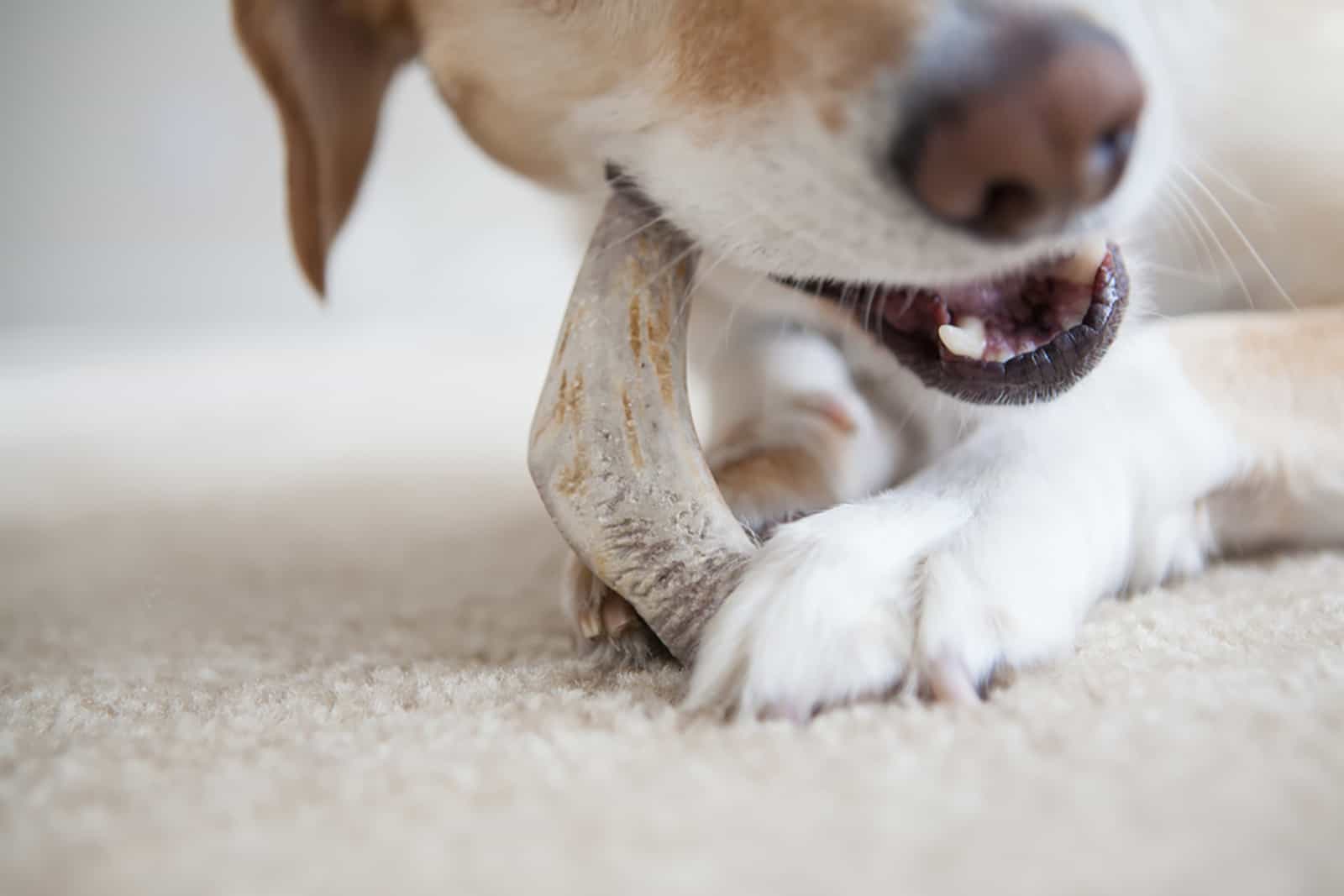
Depends on what a dog has been chewing. When dogs chew, there is higher blood circulation in their gums so it is normal for them to be an intense pink color.
However, if your dog happens to develop red gums when chewing on something, it is time to take that something away from it.
Chewing on different objects may cause injuries for dogs that can lead to gum bleeding and irritation.
For example, chewing on a basic branch can make a wound within your dog’s mouth, and that tiny wound can get infected which can lead to a more serious problem, like gingivitis, stomatitis, and periodontal disease.
So, make sure that your dog chews on something soft that is safe for its teeth and gums.
What Color Are A Dog’s Gums When They Are In Pain?
Red usually indicates inflammation which equals pain. So, red gums are a sign that your dog is in pain — its gums hurt whenever it tries to chew.
Blue gums can also mean that your dog is in pain because they represent a lack of oxygen and your dog may find breathing a chore. Blue gums in dogs can also be a shade of purple that can indicate health issues.
If you notice a black growth on your dog’s gums then you may want to call your vet to see what that is.
How To Check Your Dog’s Gum Color
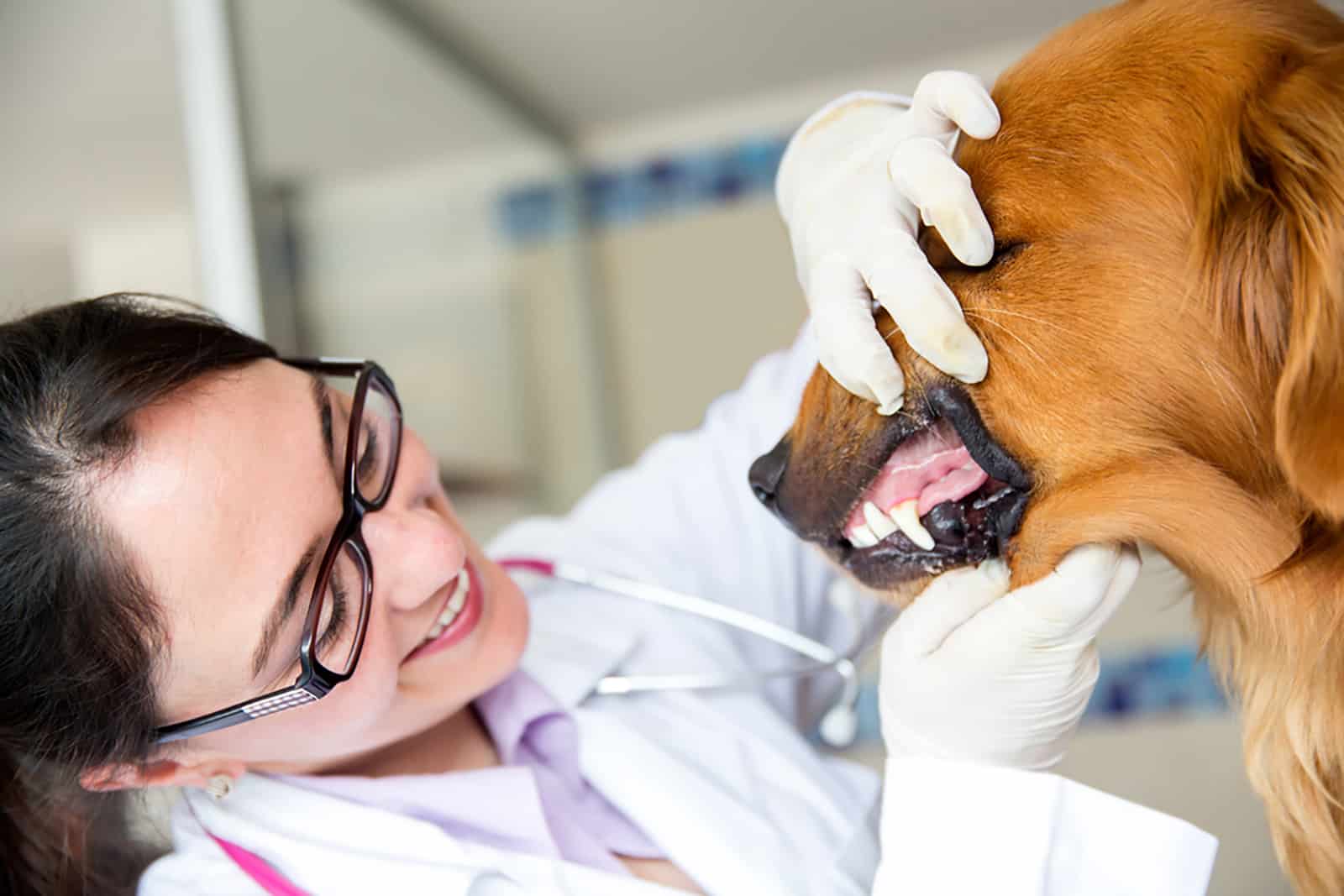
You can check your dog’s gum color at home with a very simple trick that all veterinarians do — the capillary refill time check (CRT). To make it more simple, dogs’ gums are made out of tiny blood vessels (capillaries) that are packed with blood!
Simply lift up your dog’s upper lip and apply pressure on its gums. When you apply pressure to your dog’s gums, that spot turns white but it immediately turns back to its healthy pink color. This is called the capillary refill time.
Each animal species has a different capillary refill time — a dog’s CRT is 1.5 seconds. This means that it normally takes 1.5 seconds for your dog’s capillaries to fill in the blood in its gums after you have applied pressure.
If it takes longer than 2 seconds, then that indicates low blood flow and might mean that your dog has an underlying health condition that needs to be checked by a vet.
Conclusion
Dog gum colors can change due to various health issues, but they can also change if the dog is dehydrated. The dog’s gum color chart is a very neat tool that helps owners monitor their dog’s health.
Because any dog gum color change represents a possible health problem, it should not be overlooked. That said, you should call your veterinarian whenever you notice a change as it is described in this dog gum color chart.
It is better to be on the safe side and to ask your vet what might be happening to your dog if its gum color has changed.
As a responsible dog owner, your dog’s health is your main priority so make sure to check its gum color!
Related Content
Dog Poop Color Chart: Full Guide To Your Dog’s Stool
Dog Tongue Color Chart: What Color Is A Sign Of A Healthy Dog?
